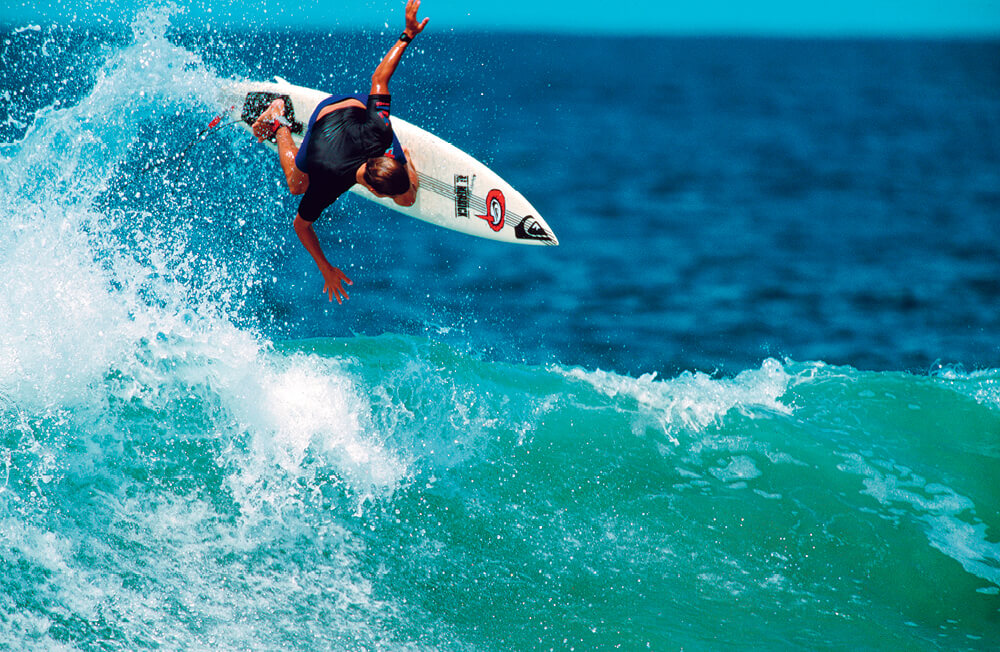24 Hours With Jack McCoy & Taylor Steele
With the Internet not yet capable of providing the speed to deliver us daily unfettered surf content, DVDs yet to become the collector’s paradigm they did in the early 2000s, and far from appearing wrapped in plastic around an issue of Waves magazine, you could argue that the 90s is the greatest era of “surf video”. And that in the 20 movies that Taylor Steele and Jack McCoy put out between them over the course of that decade, are all the nuances of the medium, the ultimate captures of 90s surfing.
In an effort to immerse myself in the 90s world of Jack McCoy and Taylor Steele I decided to watch every surf video they released in that decade, in one single day. I set aside the day, told my housemates I’d need the loungeroom for close to 20 hours, and, to keep it in line with a real 90s viewing experience, banned myself from looking at my phone, checking E-mails, Facebook, or any other digital distraction, while in the middle of a year.
It’s 2017, so I don’t have a DVD player or VCR, and all the videos I did own back then are stacked in some dusty corner in the house I grew up in, so I’ll need to do this digitally. All of Jack McCoy’s work is on his Green Room Surf Movies site, download the application and you can rent each individual movie, or you can subscribe for a month for $4.50. Bargain! And it seems Taylor Steele’s movies are available for rent on either Vimeo, iTunes, or YouTube for around $4 or $5 a pop. Which would mean this day should cost around $50 all up… Let’s do it!
1990
I wake up on a cold Wednesday morning hungover and two hours later than planned, which is disappointing, but also probably the most 90s way I could have begun this very important project, the Bob Hawke Surf Team and all that. So I fix myself some coffee and toast, get comfortable on the couch, and hit play on the first movie from either filmmaker for the decade:
Bunyip Dreaming by Jack McCoy: The feeling is exciting, the first half of this decade is full of movies I haven’t seen, on account of me being four years of age when the clock ticked over from 1989 to 1990. So I’m really looking forward to filling this black hole of my own personal surf knowledge. Bunyip Dreaming is well into McCoy’s full on embracing of Australiana. Luke Egan has long hair and is a full blown star. There’s a playful and funny approach to breaking down the movie between sections loosely following the Indigenous dreamtime, such as the text and voice-over: “Luke and Munga know the dreaming is a flow, but once Luke thought the city was the go,” before leading into a Coolangatta section where a young Occy sunbakes on the sidewalk as a high school girl steps over him. It’s all sunshine and excess. Bunyip Dreaming flies past in a brisk 38 minutes, and I drink it all in with my coffee and toast, a wonderful movie. Despite the late start I’m feeling optimistic about the project. Everything is going to be great.
1992
Momentum by Taylor Steele: I pay YouTube to rent Momentum, and I hit play. Finally! I’m seeing Momentum! The film that defines the 90s! The screen flashes names: “Taj Burrow” “Andy Irons” “Dean Morrison” Wait… what? Taj Burrow? Andy Irons? Dean Morrison? Something is wrong. What are these guys doing here in the early 90s? Then the title flashes up on the screen: “Momentum: Under The Influence” NOOOOO! This isn’t Momentum, the video forever tied to early 90s surf culture, it’s the 2001 revisit with a new generation of surfers. I double check my purchase, I’d clicked the correct movie. I head to Taylor Steele’s website which gives me links to rent and purchase his most famous video, but again the links lead to Momentum: Under The Influence. I scour the internet, sweat on my brow, heart racing, for an illegal stream, an illegal torrent, anything… but I find nothing. There is no trace of Momentum on the whole of the Internet. It’s a devastating blow. How can I do this thing without seeing Momentum? Is the project already a failure without even getting to 1993?! With the sigh of a defeated man, I queue up the next video.
Green Iguana by Jack McCoy: Luke Egan opens the film with luscious long hair and the sickest of jams inside the pocket. Occy’s surfing is timeless, and wait, who is that? A young Ross Williams? Cool! Green Iguana has a faster pace than Bunyip Dreaming, a little more punk while still hanging on to the Australiana didgeridoo vibes. A young and skinny Sunny Garcia appears looking and surfing just like Zeke Lau today. Another Yothu Yindi song kills it in this movie: “Djapana”. What a great time for Australian rock and roll. Pipeline features too and establishes that Pipeline will always be Pipeline. If Kurt Vonnegut wrote about Pipeline after watching it today and in Green Iguana, he’d write: “All time Pipeline is all time Pipeline. It does not change. It does not lend itself to warnings or explanations. It simply is. Take it moment by moment, and you will find that it is, as I’ve said before, a bug in amber.”
1993
Momentum II by Taylor Steele: Alright, it’s Taylor Steele time. Momentum II, the difficult second album to the smash hit Momentum. I open a pack of almonds and start chomping away as the early 90s pop punk smashes through the speakers. Pat O’Connell, Chris Malloy, and Pancho Sullivan open the movie. The first noticeable difference between Steele and McCoy is how short Steele’s sections are. Taylor Knox surfing to Offspring is a whole lot of fun, while Rob Machado tripping someone on a soccer field is pure gold. Machado is a stringbean teenager, but the flow he’ll become known for is so evident in contrast to the tic-tac approach of almost everyone else. There is a lot of Offspring. How weird it is to think that in 1993 no-one saw “Pretty Fly For A White Guy” or “Original Prankster” coming. If only we could go back in time and warn everyone. Ross Williams wins the award for first guy to appear in both a Steele and McCoy film, and then Dorian comes on screen and shows himself to be a level above everyone else. He even goes above the lip… kinda! The picture quality is terrible. That lo-fidelity that became so popular in the early 2010s has got nothing on this. Slater’s end section establishes Slater end sections as the sections of the decade.
Sons of Fun by Jack McCoy: The title doesn’t lie: this is fun. It’s Shane Dorian, Ross Williams, and Margo, they’re the sons… of the fun, travelling around the comp circuit in Australia, surfing with mates and all the like. After Momentum II, it’s a luxury to return to sharp shots and beautiful colours of McCoy’s more experienced handling of his more expensive equipment.
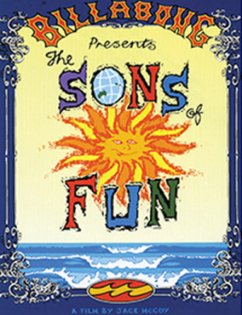 Sons of Fun is also the first quotable movie of the decade. “Margo? Margo O’Berg, she’s five time World Champion!” Says Tom Carroll, to introduce the then relatively unknown freesurfer who would go on to become the icon of 90s freesurfing.
Sons of Fun is also the first quotable movie of the decade. “Margo? Margo O’Berg, she’s five time World Champion!” Says Tom Carroll, to introduce the then relatively unknown freesurfer who would go on to become the icon of 90s freesurfing.
Kelly Slater appears, just outside the Kirra Pro, and speaks to the camera. “Ross, I’ll tell you about Ross,” says young, handsome Kelly. “He’s a good surfer, he’s got blonde hair, he’s not gay, and he’s a little taller than me…” My (gay) housemate walks in from university a few minutes later and I play it back for her. “Kelly Slater!” My housemate laughs, “His friend’s not gay? What a guy!”
1994
Focus by Taylor Steele: I eat a cheeseburger as the first wave blasts onto the projector: A Tim Curran alley oop! Airs! Hoot! As well as airs, in Focus we get our first instances of the fun-loving Taylor Steele introductions to surfer sections, like Benji Weatherly cruising around as a roller disco guy. We also find out that floaters to 360s were in vogue in 1994. Those things are everywhere. While Focus jumps from section to section, I start to understand the key difference between Taylor Steele and Jack McCoy surf videos of the 90s. Apart from the obvious things like the surfers, locations, the music, or the way they are filmed, the major difference is that Steele’s videos make you want to hang out at your local with all your friends. It’s surfing in the suburbs, the after school shenanigans you experience every single day. McCoy’s videos, on the other hand, make you want to hit the road, to go somewhere absolutely magic, again with your mates, but to experience and share something unique and beautiful and absolutely extraordinary. McCoy’s were escapist fantasy. Steele’s were every teenager with shitty school grades and angry parents.
Sik Joy by Jack McCoy: It’s 4:51pm when I hit play on Sik Joy. We’re into full on 90s music video mode now, with the overlays and aussie funk/jazz/hip hop numbers, plus some Porno For Pyros and early Powderfinger on the soundtrack too. Occy’s back! It’s been so long, all those years ago in Green Iguana was his last appearance. We establish early that this movie is going to be a slow one, but that’s alright. After squinting through the low-res Steele number it’s easy to lay back on the couch and watch crystal barrel after crystal barrel. Dorian’s in this one again, well and truly a star of both sets of movies now. Donavon Frankenreiter, grungy with long straight hair, plays electric guitar to Maldivian locals, which is fun with the benefit of knowing the soul grooving star he’d become. But I am fading, fading, fading. Holy shit, do I need that coffee.
1995
Good Times by Taylor Steele: It’s 1995 and I’m back! What a joy it is to be watching surf videos from the mid-90s. Concerned about being able to make the whole decade, I skip 1994’s Factory Seconds, which I’m led to believe is just offcuts of Steele’s Focus, and head straight for Good Times. Good Times! What a name, and boy do I need them. The filming is getting better, the music is getting better, and everyone has grown into the most 90s version of themselves. Machado is in full cult-hero mode, stylish as they come and cooler than ever. Kelly is peak Kelly – a James Dean looking superstar. Taylor Steele has hit his stride, and he’s bringing me with him. Except for a full Justin Poston section. Justin Poston? More like Justin I-don’t-care… nailed it.
Mystery Left by Jack McCoy: It’s 6:25 pm, the sun has set and the cold has set in, and still they were making surf videos in the 90s. Surf surf surf. Video video video. Mystery Left is the first of the ambitious Billabong Super Challenges (the best surfers in the world in the best waves and the precursor to the Dream Tour), and holy shit is it good. Not just because it’s good surfing, but because in half a decade of surf videos it’s the first one with a narrative, a story, something to follow, and thank god for that. Out in the West Australian desert go all the legends. Kelly and Machado, Occy and Margo, Johnny Boy Gomes and Sunny Garcia, Antman and Shane Powell. My girlfriend (her name is Christine) arrives with Thai food just in time for the best video of the decade so far. Rabbit is telling epic stories, Johnny Boy Gomes is happy and charismatic and not at all like I’d imagined he was, Slater has mastered that dramatic stand tall tube stance we see so much of today, and Machado’s hair is the best it’s ever been. Momentum gets called the movie that defined the generation, but maybe this one should be? I don’t know, I never saw Momentum.
1996
Drifting by Taylor Steele: 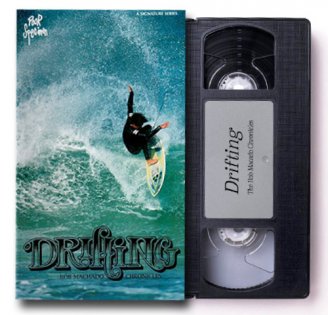 It’s 1996, we’re over the hump and into The Drifter… I mean Drifting – Taylor Steele’s Rob Machado profile film. Christine has decided that Muchacho is her favourite surfer. I don’t correct her and start calling him Muchacho myself. “Just you wait till The Show,” I tell her, “That’s the best Muchacho there is.” But boy is there a lot of Muchacho in this Drifting video. He’s everywhere. In the other vids he’s a relief. His beautiful style and awesome hair is the guac and sour cream on a surf vid’s nachos, but can you have too much of a good thing? Can you have a video of non stop Muchacho after eight hours of watching surf videos? Can you eat nachos that are actually nothing but sour cream and guac? Oh, but look, it’s Ross Williams. Every time Ross appears on screen it’s like seeing an old buddy. The one you watch all the WSL heats with today. The credits roll at 8.30pm.
It’s 1996, we’re over the hump and into The Drifter… I mean Drifting – Taylor Steele’s Rob Machado profile film. Christine has decided that Muchacho is her favourite surfer. I don’t correct her and start calling him Muchacho myself. “Just you wait till The Show,” I tell her, “That’s the best Muchacho there is.” But boy is there a lot of Muchacho in this Drifting video. He’s everywhere. In the other vids he’s a relief. His beautiful style and awesome hair is the guac and sour cream on a surf vid’s nachos, but can you have too much of a good thing? Can you have a video of non stop Muchacho after eight hours of watching surf videos? Can you eat nachos that are actually nothing but sour cream and guac? Oh, but look, it’s Ross Williams. Every time Ross appears on screen it’s like seeing an old buddy. The one you watch all the WSL heats with today. The credits roll at 8.30pm.
Psychedelic Desert Groove by Jack McCoy: 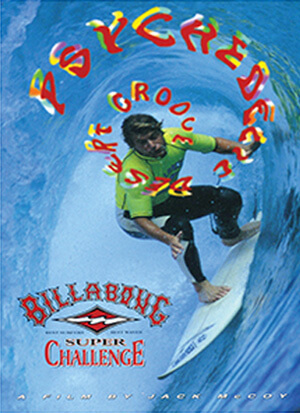 Yet another movie about surfing. Can you believe it? Have we not had enough? On we go, into a movie that in 1999 I bought in a bargain bin in suburban Melbourne for $10: Psychedelic Desert Groove. It’s encouraging to know we’re entering the surf video period of my youth and I’ll be able to enjoy them on a nostalgic level. Psychedelic Desert Groove is another installment of the Billabong Super Challenge. Pottz is in this movie, it’s the only time he makes an appearance the whole decade. As the credits roll I notice one name amongst the lists of surfers and brand people and thank yous: Taylor Steele. Taylor Steele is in the credits for Psychedelic Desert Groove. Worlds collide, let’s go to 1997.
Yet another movie about surfing. Can you believe it? Have we not had enough? On we go, into a movie that in 1999 I bought in a bargain bin in suburban Melbourne for $10: Psychedelic Desert Groove. It’s encouraging to know we’re entering the surf video period of my youth and I’ll be able to enjoy them on a nostalgic level. Psychedelic Desert Groove is another installment of the Billabong Super Challenge. Pottz is in this movie, it’s the only time he makes an appearance the whole decade. As the credits roll I notice one name amongst the lists of surfers and brand people and thank yous: Taylor Steele. Taylor Steele is in the credits for Psychedelic Desert Groove. Worlds collide, let’s go to 1997.
1997
The Show by Taylor Steele: As the opening I’ve seen hundreds of times in my childhood begins to play, I write in giant feverish letters on my notepad: “THE SHOW YEEAAAAAAH!!!” The opening music is the theme from The Godfather, and it strikes me that it was actually Taylor Steele, not Francis Ford Coppola who introduced me to its iconic melody. Then the voice over begins: “For me, Rob Machado and the boys, this was the only way to live. Anything we wanted, we just took it. Waves, broads, tacos, it was our time, and we were making it all happen.” I get goosebumps… but my Internet struggles, stopping and starting, buffering, unfairly making The Show a painful experience. By the time I get to that infamous outro action sequence, I’m furious. What is actually going on in The Show? What is this story? Dorian and Knox shoot everyone, only to be shot by Muchacho, who then also shoots Tim Curran? That’s the end? Why? Why are they shooting each other? My childhood is unravelling. I hate this. I hate surf videos. My French housemate comes in and asks me to turn the volume down because he’s trying to sleep. I hate him too.
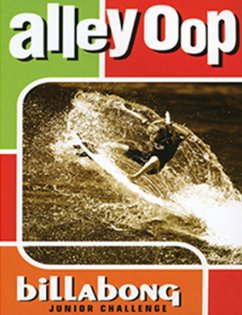 Alley Oop by Jack McCoy: Alley Oop, The Billabong Junior Challenge, was my best friend growing up. The friend I’d eat a bowl of Vita Brits with every afternoon when I’d get home from school. But did you know Alley Oop is 45 minutes? Betrayal! Still, it’s all sunshine and smiles and OMC is playing as the opening sequence introduces a happy movie. What’s great about these movies is there is so much that isn’t surfing, and let’s be real for a second, does anyone need to watch any more surfing ever again? Midway through the movie Christine goes to bed and I am left alone, wearing headphones in the dark, watching surf videos. It’s 11:40pm.
Alley Oop by Jack McCoy: Alley Oop, The Billabong Junior Challenge, was my best friend growing up. The friend I’d eat a bowl of Vita Brits with every afternoon when I’d get home from school. But did you know Alley Oop is 45 minutes? Betrayal! Still, it’s all sunshine and smiles and OMC is playing as the opening sequence introduces a happy movie. What’s great about these movies is there is so much that isn’t surfing, and let’s be real for a second, does anyone need to watch any more surfing ever again? Midway through the movie Christine goes to bed and I am left alone, wearing headphones in the dark, watching surf videos. It’s 11:40pm.
1998
All For One by Taylor Steele: There was one thing I knew about All For One when I started this project: It is listed in Taylor Steele’s filmography under the year 1998. Tonight I’ve learnt one other thing about All For One: It cannot be found on the Internet. I cross it off my list and look to the next surf movie. I feel zero remorse.
Wide Open by Jack McCoy: When I started this project, way back in 1990 with Bunyip Dreaming, I was really trying to make observations, writing down notes about the boards, the waves, the filming style, the progression of the surfing and how all that compares to today and how the films compare to one another, but I am not capable of that any more. The film, its waves, its surfing, all of it just washes over me. I never look away, I miss nothing, but none of it stays with me. Except for Andy Irons. Whenever the young Andy appears on screen my heart drops a little. “The future?” he asks himself at one point in the video, “Wide open!” Heartbreaking.
Sabotaj by Jack McCoy: It’s 1.20am, may as well hit play on Sabotaj, the excellent Taj Burrow profile film which is a glorious 28 short minutes! Powderfinger plays on the opening and it’s actually really good. Taj surfs great. Taj is a star. Taj’s parents are American. Taj is friends with Jake Paterson and Nathan Webster. Taj does a million spins in the Bumbat Challenge. Taj wins the Coke Classic at Manly. Taj Taj Taj, the great guy that is our Taj Burrow. And we’re done. Yes!
Occumentary by Jack McCoy: I’ve watched 16 surf movies to this point, and have been sitting on this couch for I don’t know how long, time is a flat circle and nothing matters anymore, but The Occumentary is delightful. The movie has aged fantastically. Occy’s story is triumphant, and feels all the more triumphant with a decade of Occy surf movies behind me. I watched The Occumentary so many times in my youth, but this fatigued delirious state might be my most enjoyable watch of it ever.
As Occy wins at Bells in 1998, his first event win since 1986 (12 freaking years), I can’t help but feel that this is the only way this movie should be watched. When “Hero” by Foo Fighters plays in the final action sequence of the video, it feels as if every video I’ve watched today has been strategically placed to build specifically for this moment. It’s triumphant. It’s heroic. I’ve been taken on a journey, and now Occy and the Foo Fighters and Jack McCoy, Green Iguana, Bunyip Dreaming, The Billabong Challenges, and all the other movies – even the ones without Occy or Jack – Focus and Factory Seconds and The Show and Momentum II… they’re all culminating right now into this final sequence of The Occumentary, culminating together into something perfect. A true masterpiece. This is better than Citizen Kane. This is better than The Godfather.
I’m standing on the couch. I am Occy and Occy is Rocky at the top of the stairs. I am Occy and Occy is Sir Edmund Hillary atop Mount Everest. I am Occy and Occy is Occy winning Bells after 12 years in the wilderness! “There goes my hero,” sings Dave Grohl, “watch him as he goes!” Is The Occumentary better than Morning of The Earth? I think so! Is it better than Endless Summer? I think so! Is it better than Momentum? I wouldn’t know, I’ve never seen it. On to 1999!
1999
Loose Change by Taylor Steele: It’s 1999, the last year of the 90s, and the light at the end of the tunnel has a lovely warm glow. As I hit play on Taylor Steele’s final movie of the decade I notice that the film is a full hour long, which at this point feels like a personal insult. The light in the tunnel dims, but then Rob Machado appears on screen in a blonde wig and riding a push bike and it’s such a good time. As good a time as the good times in Good Times!
Loose Change has a great premise: What would all the world’s leading surfers be doing with their lives if they never found surfing? Ross Williams gets an actual laugh out loud out of me with his performance as a convenience store clerk looking down scornfully on Rob Machado’s experience at Baskin Robbins. Good ol’ Ross Williams, he’s really been a faithful companion throughout this decade. The movie ends, as it should, with Kelly Slater.
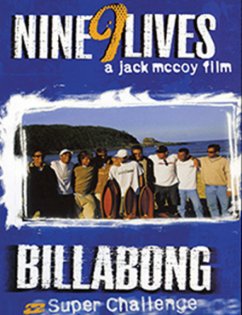 Nine Lives by Jack McCoy: It’s 4:35 am when I hit play a final time. Watching Nine Lives now as a 30 year old, and not a 13-year-old, I recognise breaks I’ve been to and surfed in the 17 years that have passed between watches. The final video of the decade is shot best of all the films, it has some of the best waves of all the films, and it’s cut together best of all the films. Pico’s “The Bay of Sin” plays.
Nine Lives by Jack McCoy: It’s 4:35 am when I hit play a final time. Watching Nine Lives now as a 30 year old, and not a 13-year-old, I recognise breaks I’ve been to and surfed in the 17 years that have passed between watches. The final video of the decade is shot best of all the films, it has some of the best waves of all the films, and it’s cut together best of all the films. Pico’s “The Bay of Sin” plays.
Occy is the beloved mascot of the generation, every time he appears on screen he says something that makes you love him all the more. The realisation that this is the year he wins the World Title is a warm one. It’s a good movie to end the 90s, with Dorian, Knox, Muchacho and Kalani Robb, the reliable McCoy team of Occy and Luke Egan, and the added stars of Sunny Garcia, Pancho Sullivan, and Tom Curren, making a neat combination of the ten years that came before it. Shane Dorian wins, and just like that it’s over. I feel nothing profound. I’ve learnt nothing but a renewed and passionate fandom of Mark Occhilupo, an appreciation of just how good Shane Dorian was before he turned into a big wave pioneer, and a disrespectful indifference to many of the surf videos I once held so dear. The screen turns black, the credits roll. The final text on the screen reads: “End of the millennium, end of the Challenge, who knows what challenges the new Millennium holds … thanks Gordon.”
It’s 5:25am. I turn off my laptop and projector. I check my phone. I go to bed.
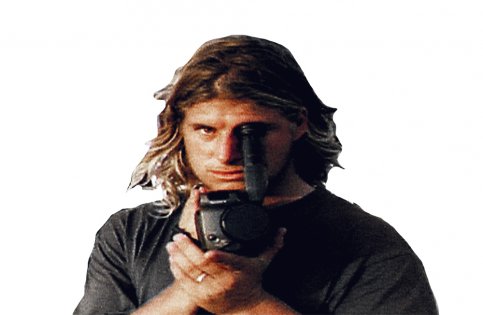
*Editor’s Note: Despite the behemoths of 90s surf film producing some of their most memorable work through the decade, Taylor and Jack have seldom crossed paths. Says Tay of Jack’s influence. “When I was starting out I loved Bunyip Dreaming. The feeling it gave me was one of pure stoke. I also loved how it started with an average wave of Munga then built off that. Occy is classic in that movie too. The scene where he pops his head out of the tent in the desert is all time. My favorite movie was Green Iguana which came out at the same time as Momentum but were polar opposites. I’m stoked that surfing back then had really different styles in surf films. – sippingjetstreams.com
Jack responded with the following. “When I was approached for some frame grabs for an article by my good friend Mike I leapt into action and had a large file dumped on VB’s desktop the next day with his promise to send me the article so I could check it out. After reading I had a funny feeling about comparing my 16mm film efforts in the 90’s to another gent who had just made his first video and then putting our efforts side by side for the next decade. I looked at it like comparing Bruce Brown’s 5th film The Endless Summer with my first film Tubular Swells. By 1990 I’d already made four full length features and three short films and went on in that 10 year period to make another 12 feature films, being the most prolific production period of my life. I love what Mike took on and what he did, it’s a great read, however again I hope no one reads this as anything more than a giggle and not to judge against. Aloha.” – jackmccoy.com
